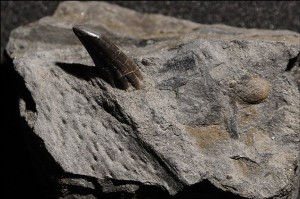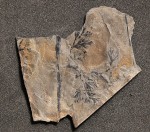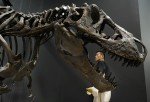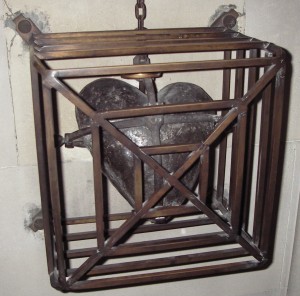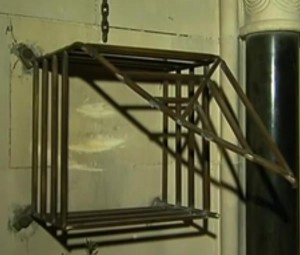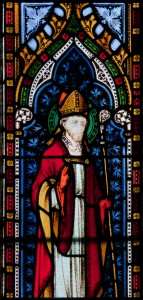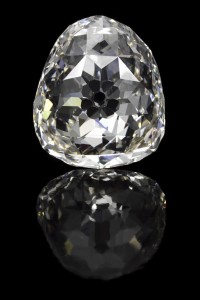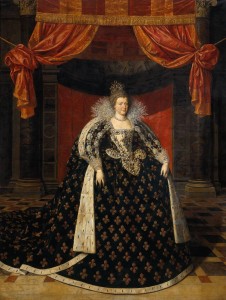 A unique cache of approximately 15 original “Keep Calm and Carry On” World War II propaganda posters were brought in for appraisal to an Antiques Roadshow event at St. Andrews University in Scotland. This is the only known collection of the original 1939 poster whose iconography has become ubiquitous over the past few years both in its original form and in countless parodies.
A unique cache of approximately 15 original “Keep Calm and Carry On” World War II propaganda posters were brought in for appraisal to an Antiques Roadshow event at St. Andrews University in Scotland. This is the only known collection of the original 1939 poster whose iconography has become ubiquitous over the past few years both in its original form and in countless parodies.
“Keep Calm and Carry On” was one of three posters designed and printed to rally the population of Britain for war before war was even declared. There wasn’t even a Ministry of Information, in fact, when the posters were first conceived, because the department responsible for propaganda and censorship had been closed at the end of World War I. Reestablishing an MOI would be tantamount to a government announcement that they expected to go to war again, so the organization was developed in secret in the late 1930s and only officially formed on September 4th, 1939, four days after the German invasion of Poland, one day after Britain declared war on Germany.
 Meanwhile, the Home Planning Committee was tasked in April of 1939 with devising poster designs that would be simple, striking and difficult for the already well-developed German propaganda machine to duplicate. They settled on three slogans printed in fine type against a single bold color backdrop topped with the only image in the series, the crown of King George VI. The first slogan printed was “Your Courage, Your Cheerfulness, Your Resolution Will Bring Us Victory,” the second “Freedom Is in Peril Defend It with All Your Might,” and the third “Keep Calm and Carry On.” The idea was to convey a message of encouragement from the King himself, a rallying cry to inspire people through the initial shocks and horrors of war on the home front.
Meanwhile, the Home Planning Committee was tasked in April of 1939 with devising poster designs that would be simple, striking and difficult for the already well-developed German propaganda machine to duplicate. They settled on three slogans printed in fine type against a single bold color backdrop topped with the only image in the series, the crown of King George VI. The first slogan printed was “Your Courage, Your Cheerfulness, Your Resolution Will Bring Us Victory,” the second “Freedom Is in Peril Defend It with All Your Might,” and the third “Keep Calm and Carry On.” The idea was to convey a message of encouragement from the King himself, a rallying cry to inspire people through the initial shocks and horrors of war on the home front.
Production on all three began in August of 1939. War was seen as inevitable by then, and the nascent Ministry wanted to have posters printed and ready for wide distribution when the other shoe dropped. A million “Your Courage” posters, 600,000 “Freedom Is in Peril” posters and 2.5 million “Keep Calm” posters were printed, but only the first two were ever distributed and posted everywhere from shop windows to outdoor advertising billboards. “Keep Calm” was kept in reserve for a top potential panic-inducing event like a German invasion of Britain. The worst case scenario didn’t happen, so “Keep Calm” never actually made it to the streets.
 After the war, paper shortages claimed much of the poster stock. Millions of “Keep Calm” posters were pulped, and since they’d never been seen in public, nobody even felt the loss. In 2000 Stuart Manley, co-owner of Barter Books, a magically delicious bookstore set in a restored Victorian train station in Alnwick, Northumberland, was going through a box of quaint and curious volumes of forgotten lore he’d purchased at auction when he found a folded poster in the bottom. White text on a red background told him to “Keep Calm and Carry On” and naturally he showed it to his wife Mary. She loved its stiff-upper-lip stoutness and the simple but compelling graphic impact, so she had it framed and put it up near the store’s cash register.
After the war, paper shortages claimed much of the poster stock. Millions of “Keep Calm” posters were pulped, and since they’d never been seen in public, nobody even felt the loss. In 2000 Stuart Manley, co-owner of Barter Books, a magically delicious bookstore set in a restored Victorian train station in Alnwick, Northumberland, was going through a box of quaint and curious volumes of forgotten lore he’d purchased at auction when he found a folded poster in the bottom. White text on a red background told him to “Keep Calm and Carry On” and naturally he showed it to his wife Mary. She loved its stiff-upper-lip stoutness and the simple but compelling graphic impact, so she had it framed and put it up near the store’s cash register.
It caused a sensation. Since the design is over 50 years old, it’s in the public domain now. The Manleys made copies to sell in the store and soon they couldn’t keep them in stock. Then the Internets got a hold of it and a meme ensued. Now you can find “Keep Calm and Carry On” and its bastard children on beach towels, coffee mugs and t-shirts everywhere, but the originals remain rarer than hens’ teeth.
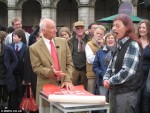 Moragh Turnbull had seen the design crop up on commercial clutter and knew she had some of those posters. Her father, William Turnbull, was a member of the Royal Observer Corps in Edinburgh. The War Office sent the ROC propaganda posters as part of their distribution network, but as we know, the “Keep Calm” posters never got the green light. Turnbull simply rolled up 15 or so posters,
Moragh Turnbull had seen the design crop up on commercial clutter and knew she had some of those posters. Her father, William Turnbull, was a member of the Royal Observer Corps in Edinburgh. The War Office sent the ROC propaganda posters as part of their distribution network, but as we know, the “Keep Calm” posters never got the green light. Turnbull simply rolled up 15 or so posters, slid a rubber band over them slid them into a tube (thank you for the correction, Moragh!) and kept them at home along with his town planning papers. He later gave the posters to his daughter Moragh.
She brought them to the Antiques Roadshow at St. Andrews where expert Paul Atterbury confirmed their authenticity and valued them at £1000 (ca. $1500) each. He told Moragh:
“This is the original and now you’re probably sitting on the world’s stock of original “Keep Calm and Carry On” posters. You have the monopoly.”
She intends to keep her monopoly for now. Since she recently lost her job, she finds the slogan comforting. In a few years she may decide to sell them to make herself a tidy little pension fund.
For more about the history of the three posters, read this fascinating extract from Rebecca Lewis’ Ph.D. dissertation on British World War II propaganda posters. Here’s a short video covering the history of the posters and, most delightfully, the beautiful restored train station bookstore.
[youtube=http://www.youtube.com/watch?v=FrHkKXFRbCI&w=430]
